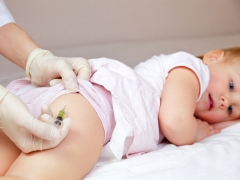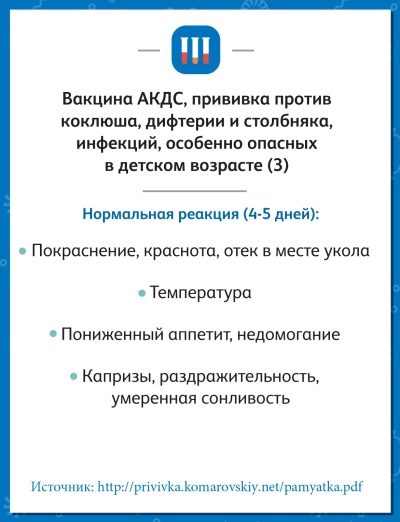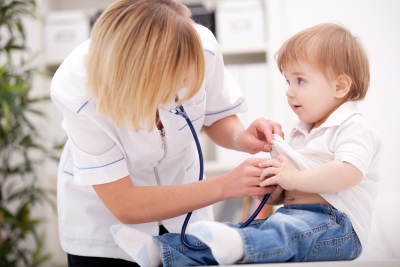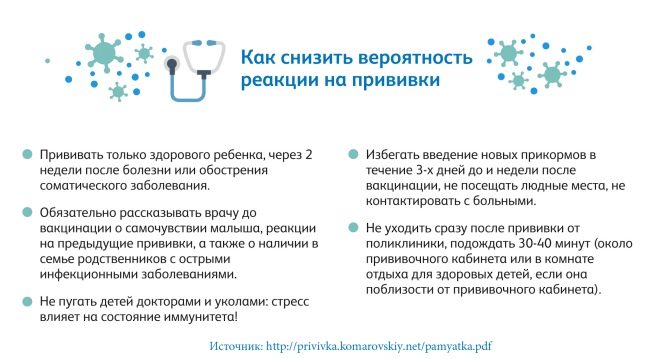Vaccination DPT: side effects in children, the pros and cons of vaccination
Inoculation of children is aimed at combating diseases that are dangerous to humans. Among the vaccinations that put children in the first year of life, there is also DPT. Let us examine in more detail the features of such a vaccine, as well as possible adverse reactions to its introduction.
What is it and what diseases are being vaccinated?
DTP vaccine is aimed at preventing the emergence of several diseases at once:
- Diphtheria;
- Tetanus;
- Whooping cough.
All these infections are classified as serious and very dangerous diseases with a high percentage of death or disability. The letters K, D and C in the title vaccines indicate these infections, and the letter A means "adsorbed".
pros
- This vaccine will protect the child from three serious diseases. Even if the baby gets infected, the disease will end quickly and without complications.
- The use of such a combination vaccine avoids three injections.
- DTP vaccination has a rather low incidence of complications.
- Domestic vaccine is available and very effective.
Minuses
- This vaccine is the most reactive, so many babies develop side effects on its administration (especially on the second or third vaccine).
- The injection is quite painful and many babies cry for a long time because of it.
- Parents have to pay for imported vaccines separately.
Possible adverse reactions
The reaction to the introduction of DPT appears in every third child, but is not a pathology, as in most cases it passes without a trace. The most common side effects are the second and third vaccinations.
There are such adverse reactions to DTP:
- Local This is a change in the skin at the injection site (redness, the appearance of hardening or swelling), as well as disturbed walking due to the pain of the injection site.
- Are common. DTP can cause hyperthermia, diarrhea, anorexia, inhibited state, vomiting, capricious mood, prolonged sleep.

Increased body temperature, as well as local changes are observed in 25% of babies. Vomiting, diarrhea, drowsiness and poor appetite are characteristic of the first day after DPT vaccination in 10% of children.
All of these side effects are found in the first day after vaccination. If several days have already passed, but they do not pass, it is likely that the child has developed an infection (very often the children become infected in the clinic while they are waiting for the manipulation).
You also need to contact a pediatrician if the reaction to vaccination is very pronounced - the injection site is very swollen (more than 8 cm), the child cries for more than 3 hours, his body temperature is more than 39 degrees.
Serious side effects and statistics on them
Complications caused by DTP vaccine can be caused by ignoring contraindications to vaccination, using a spoiled drug, or inappropriate administration of a vaccine. The frequency of occurrence of complications from DTP vaccination is 1-3 per 100 thousand.
After vaccination possible:
- Quincke’s edema;
- Symptoms of encephalopathy;
- Hives;
- Convulsions (temperature not elevated);
- Anaphylactic shock.
Seizures develop in one child for 14,500 vaccinated babies. The incidence of severe DTP allergy is 1 in a million.
It is extremely rare at the injection site that an abscess occurs that is associated with a violation of sterile conditions during vaccination. Previously, the incidence of abscesses was greater, as DTP was injected into the buttock.
Studies have not found a direct effect of DTP on neurological disorders, therefore, in the event of such complications, it is believed that the vaccine acts as a provoking factor for the manifestation of disorders that were previously but not manifested openly.
Meanwhile, it is known that the pertussis component of the vaccine irritates the lining of the brain, which causes short-term disruption of the nervous system. In such cases, DTP vaccination is no longer given to the child (they inject ADS).
Contraindications
General contraindications (when vaccinations are not carried out) are:
- The acute period of any disease;
- Allergy to any component of the vaccine;
- Immunodeficiency.
A major obstacle to the vaccination of DTP is an enlarged thymus gland. If you ignore this contraindication, vaccination can lead to big health problems in a child.
It is necessary to refuse introduction of DTP for a while during exacerbation of diathesis until remission is achieved. After a mild ORZh, a child can be vaccinated 2 weeks after recovery, and after other acute illnesses - 4 weeks.
There are also contraindications to the introduction of DTP, but allowing vaccination with ADS. These are neurological pathologies (for example, encephalopathy), the presence of seizures or allergies in the baby’s relatives, as well as prematurity.

Why vaccination is needed: the statistics speak for themselves
Currently, DPT is shown to be administered to children in all developed countries, as this vaccine saves thousands of children's lives. In some countries, over the past 5 years, a lighter version of this vaccine was used, in which the pertussis component was absent. The result was a significant increase in the incidence of whooping cough, as well as complications and deaths of this infection.
If the parents decided not to take the vaccine at all, then they are not interested in AKDD at all, but if they doubt the necessity of using such a vaccine, believing that a large number of components can harm the child, their worries are in vain. Since the components of the vaccine are aimed at different infections, they are well tolerated by the body of the baby. In addition, the compatibility of these components has been tested for years.
Recall that before the 50s, when vaccination began in Russia, diphtheria developed in 20% of children, and death was almost 50% of cases of the disease. Tetanus is an even more dangerous infection with a mortality rate of around 85%. But pertussis before the onset of vaccination, DPT developed in all children, proceeding with varying severity. Now, when all children are offered vaccination, whooping cough disease statistics has decreased by 20 times.
Why is vaccine better than disease?
Many adults have the mistaken belief that immunity after a disease is more resistant than after vaccination.This is true for some infections, but diphtheria and tetanus are not among them. If the child becomes ill with any of these infections, immunity to them will not develop. While the basic threefold vaccination using DTP will protect the baby from these diseases for a period of 6 to 12 years. As for whooping cough, immunity after its transfer appears, but its duration is the same as with the introduction of vaccination (from 6 to 10 years). It turns out that vaccination is safer and more profitable.
At what age do vaccination?
In childhood vaccinations against tetanus, whooping cough and diphtheria do three times. The interval between administration of the DTP vaccine should be between 30 and 45 days. The minimum period after which you can introduce the following vaccine to your baby is 4 weeks.
First
The vaccination calendar notes that for the first time, DPT vaccine is administered to children at 3 months of age. This is due to a decrease in the protection of the little one from infections due to the antibodies received from the mother. For the first vaccination, you can use any vaccine - both imported and domestic production. At the same time, it is noted that Infanrix is tolerated by 3-month-old babies more easily, since the pertussis component in this vaccine is cell-free.
If there were reasons to cancel the vaccination at 3 months, you can put DTP at any time before 4 years of age. If a 4-year-old child has not previously been vaccinated with DTP vaccine, he is not given this vaccine, but ADF.
The second
30-45 days after the first injection of DPT, the vaccination is repeated, so the average age for the second DPT is 4.5 months. Vaccination can be carried out as the same vaccine, which performed the first vaccination, and any other type.
The reaction to the second vaccine may be more pronounced (it is to this introduction of DTP that most babies react), but this is not a pathology, but due to the fact that the body has already become familiar with the ingredients of the vaccination and has developed a specific immune response, therefore with the second "Meeting" the response will be stronger.
The missed second DPT should be delivered immediately, as there will be such an opportunity, then the vaccination will be second and you do not need to begin the vaccination process again. If the baby had a serious reaction to the first DTP, then the second vaccine can be replaced with DTP, since it is often the pertussis component that causes the side effects of this vaccine.
Third
The third time, DTP is also given 30–45 days after the second vaccination, therefore the age of the third vaccination is often 6 months. If the vaccine is not delivered during this period, DTP should be administered as soon as possible, then the vaccine vaccine will be considered third.
In some children, the reaction to this vaccine introduction is most pronounced, which is also not considered pathology, as in the case of a reaction to the second vaccine.
The fourth injection of DPT vaccine is called the first revaccination and is carried out at the age of one and a half years (one year after the previous vaccination). It, like all subsequent vaccinations, provides support for the immunity of the child and adult from these diseases. Next, the child is not given DPT, but the version of this vaccine without pertussis toxoid - ADS-M. This vaccination is done at 7 years old, then at 14 years old, and then every 10 years during the life of an adult.
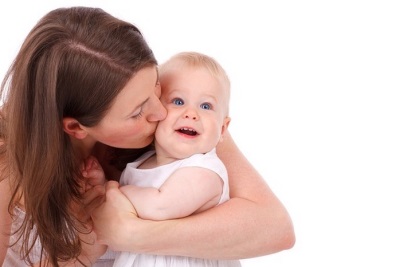
When is she needed?
Vaccination with DPT vaccine begins at an early age and maintains immunity that has developed after vaccination throughout a person’s life. This vaccination is important not only for babies in their first years of life, but also for adults, since the risk of infection with tetanus exists at any age.
In case of violation of the vaccination schedule, it is not necessary to start the DTP again from the beginning.Vaccinations continue from the stage when the next vaccination was missed.
Vaccines from different manufacturers are compatible?
Currently, DPT vaccines are manufactured by several manufacturers and may include other components. Existing vaccine options:
- Domestic DTP;
- Infanrix;
- Bubo - against tetanus, diphtheria and hepatitis B;
- Pentaxim - DTP vaccine supplemented with components that protect against hemophilic infection and polio;
- Tritanriks-HB - vaccinated against whooping cough, hepatitis B, tetanus and diphtheria;
- Tetrakok - includes DTP and polio vaccine;
- ADS - vaccine, in which there is no pertussis component (there is also ADS-M, which is administered from 6 years of age);
- AC - only against tetanus;
- AD-M - only against diphtheria.
For the first three vaccinations, it is recommended to use the same vaccines, however, if for any reason the introduction of the same vaccine is not possible, any other drug can be given to the child, because all DTPs are interchangeable.
DTP Preparation
Since reactions to DTP occur much more frequently than to other mandatory vaccinations, therefore parents and medical staff should be more attentive to both the child and the vaccination itself.
- It is important that the child be vaccinated in a healthy state.
- It is best to vaccinate the baby after a stool and on an empty stomach, while it is not recommended to wear the baby too warmly.
- Parents should purchase antipyretic drugs of several groups in different forms of release (syrup and candles).
- Drug antiallergic training has a sense to hold children who have a high risk of allergies. So children 1-2 days before vaccination begin to give antihistamines funds and continue to receive them until the third day after vaccination.
Where do the injection?
The vaccine is injected into the muscle tissue, since it is from there that the DTP components are released at the rate required for the formation of immunity. If you put the drug under the skin, it will be too long to be released, so that the injection will be useless.
For the introduction of DPT usually choose the thigh, as the muscle tissue in the legs is often well developed, even in very young children. Children of school age and adults are vaccinated to the shoulder, provided it is placed in the muscle tissue.
To introduce the vaccine into the buttocks is not recommended, since this area is characterized by a large layer of adipose tissue. In addition, with such an introduction, there is a risk of vaccine components entering the nerve or blood vessel. Intravenous administration of the drug is unacceptable.

What to do if there are negative reactions?
Immediately after the introduction of the vaccine is recommended to stay in the clinic for about 30 minutes or take a walk on the street next to the building. In this case, you can quickly get medical attention for immediate allergies.
At home, the baby is advised to immediately give the antipyretic drug and monitor the body temperature all day. Temperature increase is a frequent reaction to DTP, but since it does not affect the production of an immune response, any hyperthermia after vaccination should be eliminated with non-steroidal anti-inflammatory drugs.
When redness appears, you do not need to do anything. If a seal appears at the injection site, it can take up to two weeks to dissolve. It is also a common reaction due to localized tissue inflammation at the site where the vaccine is absorbed. To help your baby, you can use troxevasin ointment.
Some children may have a cough after DTP. It does not require any treatment if it occurs within 24 hours after vaccination. If the appearance of cough is noted later, most likely, during a visit to the clinic, the child became infected with some kind of infection.
After vaccination, give the child more drinking, and feed at will, with new products in the diet do not enter the baby. It is also recommended to limit meetings with other people and often air the room.
